By Ed McDonough
Introduction
Like many Veloce Today enthusiasts, the UK-based American automotive writer Ed McDonough (and author of “The Ferrari 156 Sharknose”) has had a long-standing and more-than-passing interest in French automobiles as well Italian machinery which he has written about in numerous articles and books. He has owned an Alpine A110 and the occasional Renault, Peugeot and Citroen, and raced in several 24-hour events with a Citroen 2CV. He has been competing this year in a 1951 DB-Monomille…more of that later!
He has now discovered a rather unique collection of cars, many of which are housed in England, with others stored in France and New Zealand. The owner has kindly agreed to a series of articles and Ed will be testing most of this extensive and relatively unknown collection of cars. It includes over a dozen Delahayes, all of which have been painstakingly restored and are in superb condition. These are not so-called ‘barn-finds’ but cars on which the very meticulous owner has lavished much attention. We start this series with a 1948 135M with a charming coupe body by Parisian designer/coach-builder Henri Chapron, and some background information on the Delahaye firm.
Delahaye conjures up a mixed vision of large and long French Grand Prix and sports cars of the late 1930s and a variety of extraordinary coach-built luxury machines constructed in that post-war decade of the late 1940s through the middle of the 1950s.
The name remains little known to most people, and even the enthusiasts are unlikely to be aware of the diversity of machinery that came from the French company. The victories of the Type 135 at Le Mans and in the Monte Carlo rally in 1938 are very well recorded, as is the 4th place taken by a V-12-engined car at the Mille Miglia in that year. But there was a great deal that came before and after that significant year, before the start of WWII.
Emile Delahaye was an ambitious man, and in1890 he took over a machine shop in Tours in France which had been in existence since 1845. Delahaye had been the chief engineer for a Belgian-French company which was building railroad stock and equipment. The firm he took over had been making steam, gas and paraffin engines, mostly for industrial use. By 1894, when Benz was in the early years of automotive production, Delahaye was building a car similar to the first Benz, with a four-cylinder engine and a tubular chassis, with tubular radiators. Progress on this machine was promising enough to gain an entry for two cars in the 1896 Paris-Marseilles-Paris road race.
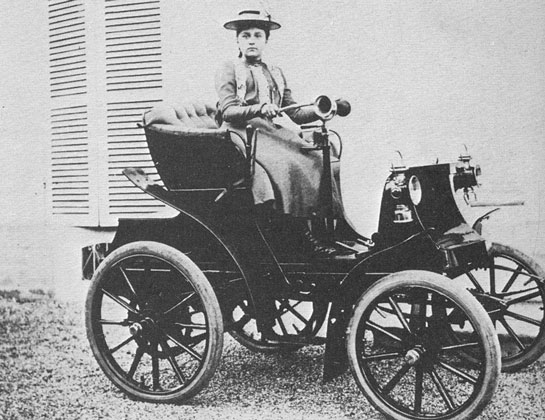
Tentative identification of this Delahaye is a 1900 6hp Type 2, with tubular frame and radiator. It had a very successful run, with 375 Type 1s and 225 Type 2s being built in a five year period of time. The tiller steering would persist until 1902.
This race lasted ten days, much of it over roads that were turned into great muddy quagmires by one of the worst storms in France for many years. Delahaye drove one of the cars himself, and his second car was handled by ‘veteran’ automotive adventurer Ernest Archdeacon. Archdeacon finished 6th at an average speed of 14 mph, while Delahaye himself was 8th at 14 mph. The winner was Mayade in a Panhard at 15.7 mph. The new Delahaye auto was widely praised for its rugged endurance, and its reputation as a racing machine was already assured.
The company built a car with a longer wheelbase for the 1897 Paris to Dieppe race, where Archdeacon was 6th but Courtoise won the 6-seater class with a very large-bodied car with a 6 hp engine…the start of Delahaye’s love of big machines. By 1898, several races had taken place, business was good, so the company moved from its base in Tours to Paris. The new factory had been owned by the father of one of Delahaye’s new partners, Georges Morane. Leon Desmarais was the other partner, and Charles Weiffenbach was appointed as the works manager.
Three different models were built before 1900, the Types 1, 2 and Zero, all with rear mounted water-cooled engines, with final drive by side chains, with three forward gears and one reverse, and steering was achieved by bicycle type handle-bars on a column. Delahaye himself retired in 1901 and the company was then led by Desmarais and Morane until 1906 by which time Weiffenbach, or as he had become known, Monsieur Charles took charge. New models appeared including the Type 10B with a front-mounted twin-cylinder engine. This car ran in the Paris-Vienna and Circuit des Ardennes races in 1902, the last racing appearances of Delahayes for the next thirty years. Four-cylinder engines were on the scene in 1903, and just a few years later the Type 21 had a 4.9-liter engine with the first use of water jacketing of the exhaust manifold. In the move to fixed head engines by most manufacturers, Delahaye stuck with detachable heads. An 8-liter double chain-driven car appeared in 1905, with two handbrakes and two footbrakes to prevent overheating in the separate drum brake systems.
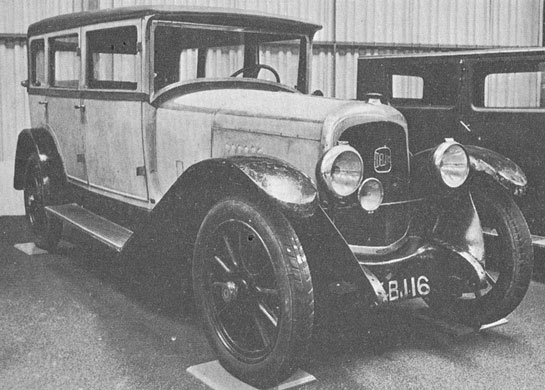
After WWI, the firm produced stodgy, dependable and totally uninteresting automobiles. This 1925 Type 87 with a 1.8 liter four was typical of the products of the time. The 1935 Type 135 would revolutionize the company, even though it was still a conservative design.
Shaft drive appeared on many of the cars by 1907 though chain drive remained on the larger machines until 1911. Cars were being produced under license in Germany and Delahaye broke into the English market in 1909. In that same year, the White Steam Car Company gave up on steam engines and produced a gasoline powered car that was virtually a copy of the Delahaye. This would have gone to court had WWI not intervened. The post-WWI Delahayes, from 1920 to 1930, were dull and banal compared to their earlier counterparts. Monsieur Charles’ efforts to emulate General Motors were not working, and in the Depression years of the early 1930s, the cars were not selling.
Thus, Weiffenbach…Monsieur Charles…did a complete about face and decided the company would produce performance vehicles. A six-cylinder, 3.2-liter pushrod engine in the very light Superluxe chassis appeared at the 1933 Paris Show. This car had transverse independent front suspension, a streamlined body and the choice of either the Cotal electromagnetic gearbox or synchromesh. There was also a 4-cylinder engine and a sports variation…the18 Sport. This latter car established an impressive number of world and international class records in 1934, managing 48-hours around Montlhery at an average of over 107 mph. Then, in 1935 and 1936, came the new model…the Delahaye 135.
The 135 and 135M
The 18 Sport was developed into a new model, the ‘Coupes des Alpes’ model following its success in the 1935 Alpine Trial. This 3.2-liter, 110 bhp car then evolved from the six-cylinder Superluxe into the prototype road-going 135. Delahaye and Delage had merged during 1935 and the Delage company’s race experience was drawn on to make the Delahaye a racier performance machine. Thus a 3.5-liter model also appeared, known variously as the 135M or 135 Competition. 1936 was a very successful year in competition for the firm, breaking the Ulster TT lap record and being beaten only by a ‘tank’ bodied Bugatti Type 57S at the French Grand Prix. The following year the 135 Competition nearly won at Le Mans, took the 12 Hours at Donington and took the outright win on the Monte Carlo Rally.
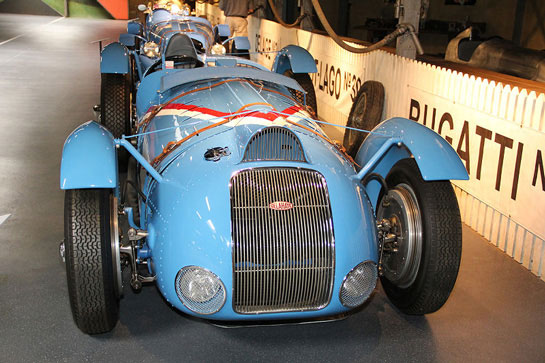
According to the Mullin, this is the T145, chassis 48771 that actually won the 1938 Pau Grand Prix and the one hundred million francs that was offered as a prize. The Franay bodied car above may be the same car. Photo by Hugues Vanhoolandt.
That year, Monsieur Charles had his team turn the 135 into the 145 with a de Dion back axle and a 4.5-liter V-12 pushrod engine. In 1938 Rene Dreyfus took one of these cars to a superb victory over the Mercedes W154 at the Pau Grand Prix. The icing on the cake in 1938, however, was 135’s outright win at the Le Mans 24 Hours.
Then war came to Europe and production stopped with the German occupation of France. When it started up again in 1946, motor racing resumed, and some changes took place at Delahaye.
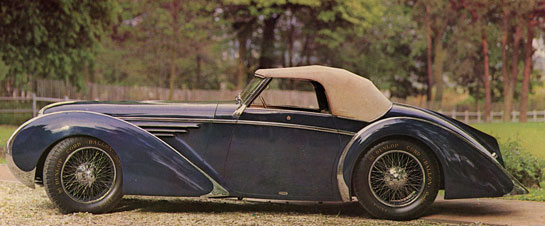
The Type 145 V12 is probably the most desirable Delahaye ever, and there may have been as few as three of these Grand Prix based road cars built. This is reportedly a Type 145 by Franay and may be the Dreyfus 4.5 liter GP car with which he won the Pau GP in 1938. There were at least two V12 coupes built by Chapron.
Delahaye had race victories at Chimay and Comminges. The post-war sports model was now officially known as the 135M, essentially the same chassis as the pre-war car with the 3.5 engine. But styles had begun to change. Philippe Charbonneaux was in charge of coachwork design at Delahaye. Charbonneaux designed bodies for the company to produce itself but he was also influential in the swing towards a more ‘transatlantic’ approach to body styling. This meant rather wider bodies extending over front and rear wheels. This ‘disappearance’ of the pronounced and almost separate wing or fender sections was opposed by the specialists and they continued to produce very elegant bodies which looked very much pre-war. By 1947, Charbonneaux was at work on the Type 175 which would appear the following year, a car with ‘his’ body style and a seven main bearing engine and a 4.5-liter six cylinder engine. But the specialist coach builders continued with their art, some exotic designs bordering on the bizarre.
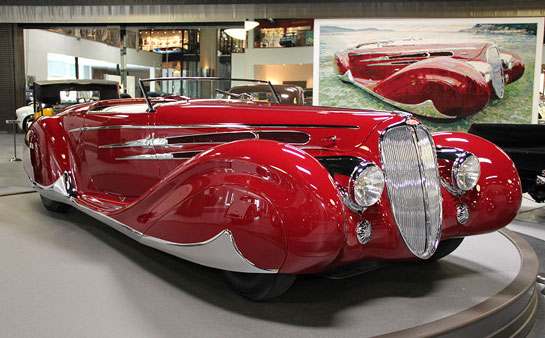
This is the ultra rare Type 165 of 1939. Using the 4.5 liter Grand Prix V12, the few that were made had conventional rear axles instead of the de Dion of the Type 145. This particular car was imported to the U.S. for the 1939 World’s Fair at New York, sans running engine. Many years later a proper V12 was found and installed. The car is at the Mullin Museum today. Photo by Hugues Vanhoolandt.
The first 135 models had had an engine capacity of 3227 cc and that was soon enlarged to 3557 cc which was to be the basis of the various competition models. The original engine was used in saloons and a number of commercial vehicles, though it would be very unfair to say Delahayes were based on trucks! After all, Jaguar did the same thing. The larger engine was fitted with three downdraught carbs and produced some 120 bhp while the competition versions had triple horizontal carburetion with twin chokes and 160 bhp. It was a four main bearing engine which limited the revs but the torque of these six cylinder engines was very impressive.
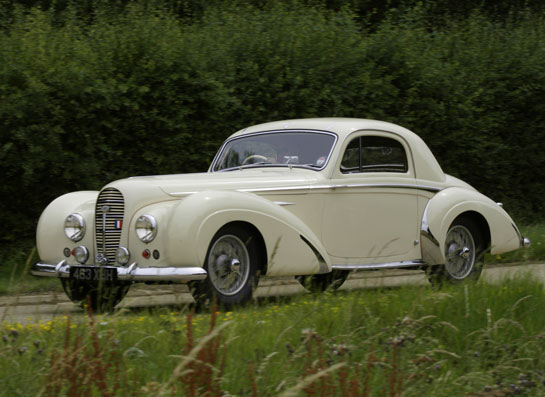
It was the Type 135 that made the marque. Oft-told apocryphal stories told how Ettore Bugatti told Weiffenbach to lighten up and increase the speed and style of his line. Perhaps. But the increased horsepower and shorter chassis created a model that would last almost twenty years. Here is chassis 800977 that Ed McDonough drove for VeloceToday.
It was thus not a surprise when quite distinct applications of Delahaye technology occurred. The chassis was fairly conventional, though it had independent front suspension with upper wishbones and a lower transverse leaf spring, with quite lengthy torque arms. There were leaf springs in the rear and a live axle, and four wheel drum brakes…very large drum brakes. The chassis lent itself to competition use and it was not long before very sleek, lightweight bodies were built for serious racing. The sophistication of the overall package did not escape the notice of the enthusiast wanting a high performance road machines, so a wide variety of bodies were designed for the 135M chassis and engine.
One of the first manufacturers to offer cars in the immediate post war era, Delahaye saw its sales soar in the years from 1947-1950. The now famous Type 135 was still in production and in 1948 the 4.5 liter Type 175 was introduced, the first Delahaye with hydraulic brakes. In 1950 the smaller 3.5 liter Type 235 debuted, but it was too late; sales of the combined Delahaye/Delage marque, at 483 in 1950, dropped to a mere 77 units in 1951.
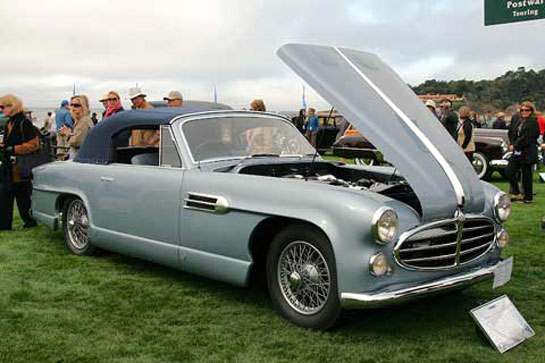
The Type 235 was Delahaye’s last call. This 1952 drophead coupe was built by the coachbuilder of Letourneur et Marchand cabriolet and owned by Alexandra & Charles Morse. Photo by Hugues Vanhoolandt.
Sadly, the days of the grand elegant tourer were coming to an end and as the 1950 years passed, so did the cars. In France and the rest of Europe, the economies could no longer afford such luxuries. Even though Delahaye/Delage was acquired by Hotchkiss in 1954, all three soon disappeared.
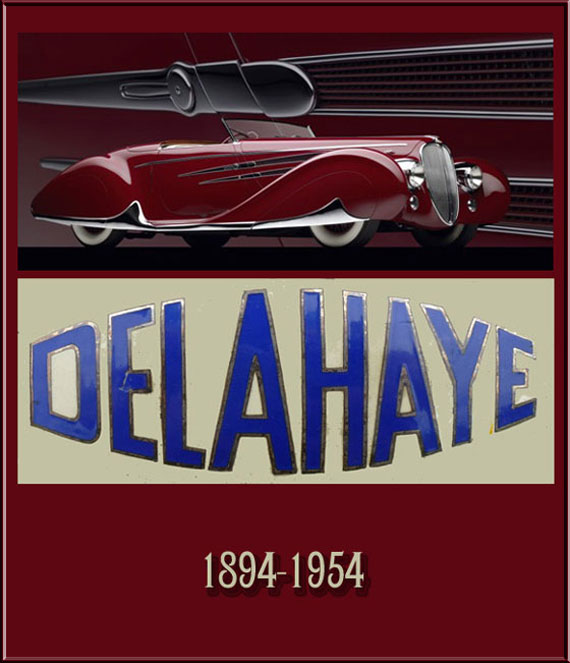
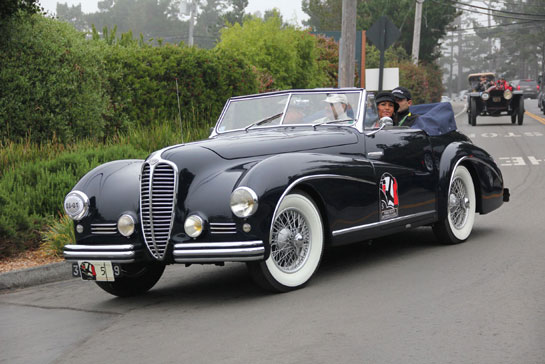
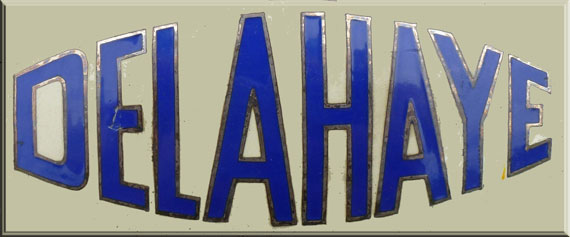
There is a question about the ” one hundred million franc” the Sam & Emily Mann collection believe there car is the 1938 Pau Grand Prix winner. They also have a Franay Delahaye.
Et Al,
I am always amazed of the Delahaye, and who owns what and how much monies was paid,etc,etc. In 1955, I purchased a Figoni Convertible Type 175 for $800.00 and actually drove it daily as my only car (Now they are in shows, and all ooh and aah), Does anyone today drive everyday. I , as a US Serviceman, in France drove the Delahaye to Paris, racing through the streets of the wet cobblestone streets, and once lost a wheel on the 175 (The rear independent suspision (De Dion) was a disaster, and was the DuBonnet front ‘Knee Action” suspension. It was filled with 20weight motor oil!!! The stores I could tell or rather it could tell…would probably blush the new owners today. While belonging to the French Delahaye Club, I presented the club with a photo of “Jacqueline” posed over the famed Delahaye grill. Most appreciative of the Club for a picture of “Jacqueline”! I brought the car back to the USA, and with the Cotal gear box working only in fourth gear. I sourced a box from a Mr Lyons in Luxembourg…who sent it to the US. Installed, I sold the 175 for…..yes $800.00 and reenlisted in the service……I know drive a Citroen SM. Alas..
I just now got around to reading the October 12 article on Delahaye. On October 11th I moved from Loveland, CO to Colorado Springs. This is a great article on a great car that few of us know enough about. Congratulations on presenting it.